
In the late 1990s a new Labour government stormed to victory. An admiring, uncritical media allowed terrible mistakes to be made without criticism. The chancellor of the Exchequer, Gordon Brown, was viewed as a genius who promised us “no more boom and bust”. In the midst of these heady days, he made a major strategic decision. He sold 400 tonnes of gold from UK reserves.
As someone who worked in and around the London Metal Exchange for over 20 years, I was familiar with the short-term arguments against holding gold. It did not yield interest and the buyers had to pay storage charges. Don’t hold gold, said all the big financial institutions.

Over a prawn cocktail offensive, as Labour convinced the City that they presented no threat, Gordon Brown became convinced of the argument. Gold, he said, was a barbarous relic in this brave new world. He sold the 400 tonnes at just $275 an ounce on average. (These days it trades near $2,000.)
Working with a Southampton jeweller, I tried to raise the money to injunct the government, to stop the sale and to hold a review.
How the press laughed and mocked us. We failed to raise the money.
Had the review taken place, a very different picture would have emerged. Whilst gold can be highly volatile and goes through some bull and bear markets, as do all commodities, over the long term it has proved to be a great store of value.
The problem is that the financial services industry, the very one that controls your money, takes a short-term view. Their priority are fees and commissions. As a result of this, UK taxpayers lost billions of pounds and our resources were seriously depleted.
In this pandemic, we have seen government debt rise more quickly than it did during the last world war. It is also possible that future Covid-19 variants will see the stockmarket rally evaporate. Our miracle vaccines are not proving to be as effective as we first hoped.
It’s the same all over the Western world. This huge level of debt could lead to future inflation and put further strains on the banking system.
Without wishing to be overly pessimistic, the point that I am making is that we live in an uncertain world and one of the best hedges against this is to own gold.
The important thing about the research that I am presenting to you is that if you wish to own gold, do make sure you are doing so in a secure way and not paying massive premiums. Securely held gold could be the wisest financial investment you ever make.

Nigel Farage
Founder, Fortune & Freedom
Why is the gold market heating up now?

Gold.
It conjures all manner of emotions in men – especially these days.
The heavy yellow metal is in high demand right now. And it’s hard to imagine a world where that’s going to change with the spread of coronavirus and its economic consequences.
Why? Because gold protects wealth. It has retained its purchasing power throughout history.
And coronavirus has poured accelerant on to a situation that was already making people question the value of their money.
When paper currencies lose their value, gold absorbs the fall in the form of a higher price. The backdrop to higher gold prices in recent years has been central banks lowering interest rates to drive down the value of paper money and stimulate spending. We are seeing this in spades right now. But, crucially, we are also seeing governments maxing out their credit cards and then some. This combination is behind the increased demand for gold and the surging gold price.
Since March 2020, governments around the world have delved into this currency debasing realm.
Now let’s take a look at the government spending programmes. Data from Bloomberg shows how much cash governments around the world are injecting into their economies to deal with the crisis.
The German government, legendarily reluctant to spend cash due to memories of the Weimar hyperinflation, finally broke its habit and pledged over $1 trillion in spending. This is a huge departure from the norm for one of the most fiscally tight economies in the world, and is indicative of a future which involves a lot more government. Importantly for gold, it is also indicative of a future with much more inflation. Which the gold price absorbs.
This binary combination of low interest rates and high government spending is quite the cocktail. However, those uber-low interest rates are also debilitating for banks (who require positive interest rates to earn money in the traditional manner). And trouble in the banking system is yet another reason why folks own gold…
But do they truly understand it? We believe you should, before you decide whether gold is for you. So, let’s dig in.
Understanding gold
Gold is the world’s most polarising asset. People either love it or hate it. You’ll be denigrated a gold bug for owning it, or an ignorant moron for not.
There are good reasons for this division. Gold’s position is an odd one thanks to its characteristics, history and the way it’s traded today.
Nobody can agree on any of those three, so they can’t agree about whether you should invest in gold either.
Some people will tell you gold is the only true form of money itself, while others will decry its uselessness because you can’t spend it. Some will tell you about how gold was money for thousands of years, while others will point out that we finally managed to get rid of it last century. The same facts often lead people to opposite conclusions.
The same people who were once staunch advocates of gold can go to being its harshest critics and then return to favour it over the course of their career. Last year, famed investor Warren Buffett bought a gold stock after years of disparaging the yellow metal.
But the best example of this is former Federal Reserve chair Alan Greenspan. Even gold investors can’t agree whether he’s a hero or a villain in the story of gold. His commonly quoted declarations go either way. He seems to have changed his mind about gold at least twice.
In the midst of all this, it’s tough to untangle any truths or reach any certain conclusions about gold. After all, when it comes to financial markets, the truth is what enough people perceive it to be.
In the end, you’ll have to make up your own mind about gold. But here is the best possible primer I can give you to do just that…
How the gold price is set
Gold is somewhat of an odd investment thanks to its history. For much of the history of money, gold was money itself. Or the determining factor in the value of currencies. Each different currency represented a redeemable amount of gold (or silver). This meant there wasn’t really a price of gold as such. Gold was money – the constant in a world of changing currencies.
But that ended when the US abandoned the last remnants of the gold standard in the 1970s and the US dollar became the world’s reserve currency without any precious metal backing. That unleashed gold prices from their anchor to currencies. The chart below shows the history of the gold price in US dollars since 1973.
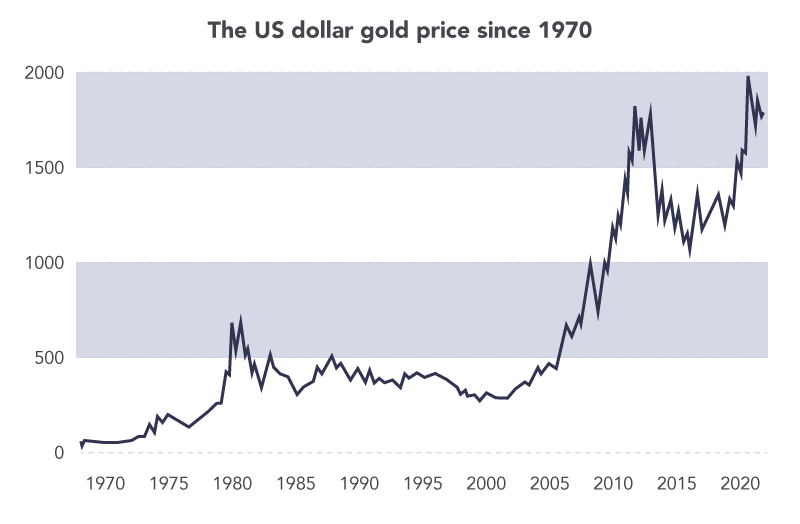
Source: LBMA
From $38.90 in 1970 to around $1,800 today, it has been quite a ride.
Keep in mind that a lot of this rise is due to inflation. Gold itself didn’t go up in value as much as the chart suggests. It’s more a devaluation of the US dollar. But that’s precisely what gold is supposed to protect investors from, of course. The devaluation of money, better known as inflation.
Back to our topic in this section. These days, the gold price is primarily set in financial markets, just like for other metals. In fact, about 15,000 times more gold is traded in financial markets than there is actual physical gold in the trading process. And almost all contracts settle in cash, not gold. Although both of these facts have come under pressure recently. But that’s another story.
I hope you can see how the gold price is completely financialised. Meaning it has become a financial market trading price, not the price of getting your hands on a physical ounce of gold. The supply and demand for physical gold seem to matter very little in setting the price. Many argue this means the gold price is manipulated.
The financial market price is set between the London Bullion Market Association’s trading and the COMEX contracts in Chicago. The LBMA handles the so called “spot” price of physical gold, while the COMEX is the biggest derivatives market in the world.
The power of Asian gold exchanges has been growing, but they’re far from matching the US hold on gold. Still, once you string together all the different gold trading houses, there is effectively a 24-hour price of gold. It’s always being bought and sold somewhere.
The past performance of gold
Gold’s ability to preserve purchasing power is unmatched. A few thousand years ago, an ounce of gold would’ve bought you a toga and sandals in Rome. Today, an ounce of gold is worth about the price of an Italian suit and shoes.
BullionStar did the maths in terms of British pounds for the last 500 years. It concluded that gold’s purchasing power is volatile in the short term, but remarkably stable over the long term:
[…] while there is no exact constant in economics, the stability of gold’s purchasing power is unprecedented. Not only on a gold standard the metal shows it’s constant nature, but also off the gold standard gold’s purchasing power is remarkably constant, albeit more volatile in the short term.
This in stark contrast to the fiat money system, which has crashed in value over time. About 300 years ago, the gold price set by Sir Isaac Newton as Master of the Mint was about £4.30. Today, the gold price is £1,300.
In case you don’t believe inflation statistics going back 500 years, which you shouldn’t, consider this comparison from Doug Casey of Casey Research in 2009. He used US dollars and silver instead of gold for some of the analysis, because silver was the currency for common use, historically speaking. But the extraordinary stability of both precious metals to preserve purchasing power over long periods of time is obvious:
Gold’s primary purpose is to preserve your purchasing power. Whether it be roaring inflation, or dollar debasement, or economic upheaval, or out-of-control government spending, it has been the absolute best form of protection throughout the history of mankind. And I can prove it.
Let’s trace what an ounce of gold or silver – true money – has been able to purchase at various periods in history, and how it compares to today.
1979: Gold’s average price that year was $306.68. This bought an average-priced full size bed.
30 years later, $950 would still buy you a full size bed.
1963: A gallon of gasoline in America sold for 31 cents. This meant that 3 silver dimes could buy a gallon of gasoline. The total weight of silver in 3 silver dimes is 0.217 of an ounce.
Today, 3 silver dimes would buy a gallon of gasoline anywhere in the U.S.
600 AD: In the Middle East, a chicken at the time of Mohammad would cost a family one silver Dirham (3 grams).
Today, 1,400 years later, a chicken in the Middle East would still cost a family one silver Dirham.
Time of Christ: Under the Roman Empire, an ounce of gold purchased a Roman citizen his toga (suit), a leather belt, and a pair of sandals.
Today, one ounce of gold will still buy a man a suit, a leather belt, and a pair of shoes.
400 BC: Some scholars report that during the reign of King Nebuchadnezzar, an ounce of gold bought 350 loaves of bread.
Today, an ounce of gold still buys about 350 loaves ($950 divided by 350 = $2.73/loaf).
1000 BC: King Solomon was known to have purchased many horses for his army. Historical records show he bought them in Egypt for 150 shekels of silver each. 150 shekels was about 55 troy ounces of silver.
Today, you can still buy a riding horse for 55 troy ounces of silver ($800).
Of course, the short-term volatility of the gold and silver price can be important too. But I hope you can see that preserving wealth over time is the immense power of gold. It’s why wealthy families own the stuff – wealth preservation. There is no asset that does it better.
But the long-term value of gold is only part of gold’s credentials as a wealth preserver.
What booms when everything else crashes?
Thanks to the value people place on gold’s long-term stability, the price surges during crises, when people rush in to buy gold. The 2008 financial crisis and the 2020 Covid-19 crisis put that on display nicely. Gold performed well both times, as you can see in these charts.
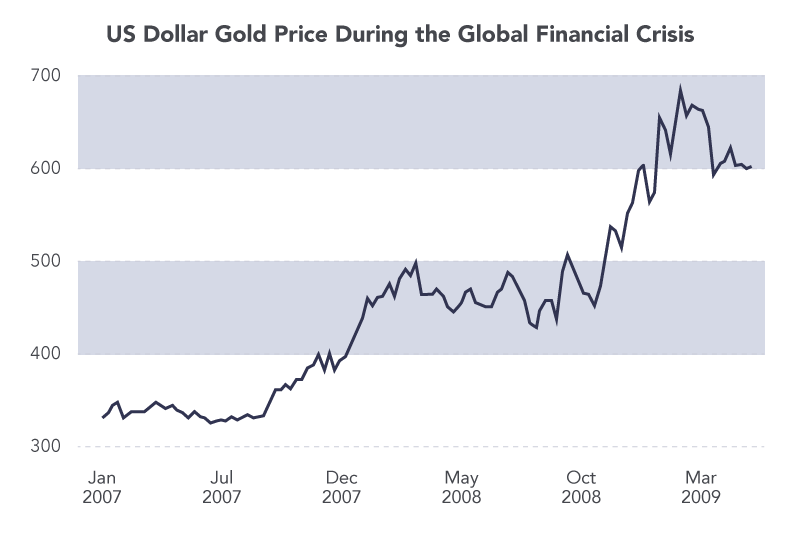
Source: Metalsdaily.com
A 50% gain while stocks crashed in 2008 and 2009?

Source: Metalsdaily.com
A 25% gain and all time highs in the midst of a pandemic and lockdown?
Even a small allocation to gold would’ve offset the disastrous returns elsewhere. Not to mention the peace of mind while banks went broke and the economy into lockdown.
The thing is, wealth preservation only matters at certain times in history. Times of turmoil, war, currency debasement and financial panics.
But these are often difficult to predict accurately, so it’s always a good idea to own some gold. Many advocates choose 10% of your investable wealth as the rule of thumb.
If you did that, how did you gold hoard perform? Well, believe it or not, gold has outperformed most other major asset classes over the past 20 years.
Also, gold was the highest performing asset class between 2000 and 2020.
Buying gold as an investment
So, should you own gold as a performing investment as well? Do we expect the price of gold to continue to outpace other investments?
Firstly, don’t forget to keep any gold investing separate to the ideas of long-term wealth preservation. I think owning some gold is pretty much required if you want your wealth to be robust. Whereas investing in additional gold for gains is only a good idea sometimes.
The confusing part is, you want to own gold as an investment when the likelihood of turmoil is rising – just when wealth preservation becomes more important. But nonetheless, keep your investment gold separate from your wealth preservation gold, at least in your mind.
So, how has gold performed as an investment for British investors? As I mentioned, gold outperforms during crises and in the build up to one. The rest of the time, it languishes.
Gold rallied from £700 to over £1,000 in anticipation of the Brexit vote, which sent shockwaves through the stockmarket. It rose 50% during the financial crisis while stocks crashed. And during the Covid-19 crisis, it surged to all-time highs.
The rest of the time, gold usually didn’t quite manage to keep up with the stockmarket.
This 20 year chart shows the British pound gold price and its excellent performance during times of trouble – 2008, 2020 and Brexit, for example

Source: Metalsdaily.com
But if you would like to speculate on the gold price, there may be a better way to do so than owning the metal itself.
Gold vs silver, gold stocks and bitcoin
Gold is often compared to a variety of assets. This can reveal its strengths and weakness
The closest competitor is silver. This cheaper cousin of gold has much the same monetary history, as Doug Casey’s historical calculations displayed earlier. In fact, there’s a good reason our British currency is called the pound sterling. It used to be a pound of sterling silver.
These days, it takes about £250 to buy a pound of sterling silver… that shows just how much inflation has devalued the pound over time. But it’s their differences that make gold and silver interesting. Silver has far more industrial uses than gold. So it can surge during good economic times too. Gold is mostly just a precious metal, not an industrial one. Although jewellery demand is significant.
As for the prices, one way you can look at the relationship between gold and silver is the gold to-silver ratio. The number tells you how many ounces of silver it takes to buy an ounce of gold. This chart shows 100 years’ worth of data.
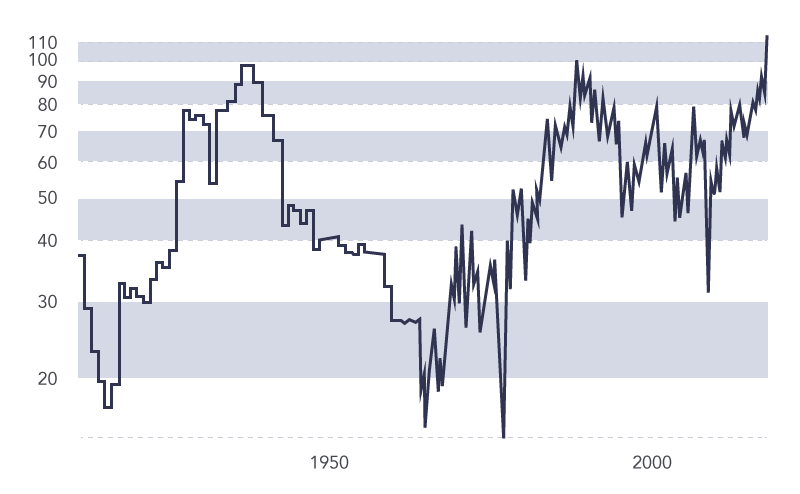
Source: Macrotrends
When the grey line is at highs, silver is cheap and gold is expensive relative to each other . Right now, buying silver looks like a good bet. But the silver price per gram can move quite fast. To check the silver price in the UK, click here.
Another way to invest in gold is to buy shares in gold companies. This introduces new risks and opportunities. Although the gold price is still an important factor, the risks and rewards of owing a stake in a mining company are greater. In some cases, far greater.
Lately, thanks to the bitcoin boom , you often hear people comparing cryptocurrencies to gold. Indeed, over 100 cryptocurrencies are gold backed . The similarities and differences are intriguing.
Both gold and cryptocurrencies are non-financial assets, meaning they exist outside the financial system. As you discovered above, this is only true to a limited extent when it comes to their price. But for both assets, it is possible to escape the financial world entirely while holding your wealth in them. That’s a huge benefit if the financial system freezes or is frozen by the government.
The gold price and bitcoin price both seem to respond to geopolitical turmoil. People buy both assets when their government is cracking down or breaking up. This makes them a good way to trade that sort of instability.
The key differences are that bitcoin is digital, relies on infrastructure and is far more volatile. Gold is tangible, historically proven and more stable.
That’s not to say gold is superior. It’s just that the assets are and therefore behave differently in different circumstances. Consider what you’re trying to achieve before deciding which one to buy.
The gold quadrants
There’s a particular reason to own gold which most British investors don’t know about, or never consider.
That’s because the majority of investment advice in favour of gold comes out of the US.
Ironically enough, American investors benefit least of all from owning gold. The Brits are somewhere in between, while the Australians and Canadians see their gold returns skyrocket during a crisis.
Why? Currencies and their exchange rates.
Gold, like oil, is priced in US dollars. That price is then converted to your local currency to get the local gold price. Even if the gold price is steady, changing exchange rates mean changing local gold prices around the world.
This creates an added complication for gold investors outside the US. They also have to take into account exchange rate moves.
How will their currency perform in different scenarios? Will it offset their gains or losses in gold, or will it add to them? After all, similar variables affect both the gold and currency markets. Money printing, crises and plain old GDP growth, for example.
If you want to understand how the exchange rate and the gold price work together, you can think about it in terms of what I call the gold quadrants.
The gold quadrants are the four possible outcomes when you invest in gold as a British investor. The gold price in US dollars can go up or down. And the US dollar to pound exchange rate, which gives you the pound gold price, can go up or down too.
Two variables give you four possible outcomes.
Say the gold price in US dollars goes up 5% and the pound goes up 5% too. That leaves the UK gold price with no change. That’s because the gains in gold are cancelled out by the lower amount of pounds you get for your US dollars.
This is only one of four possibilities. I’ve put all four possibilities in a table — the Gold Quadrants Table.
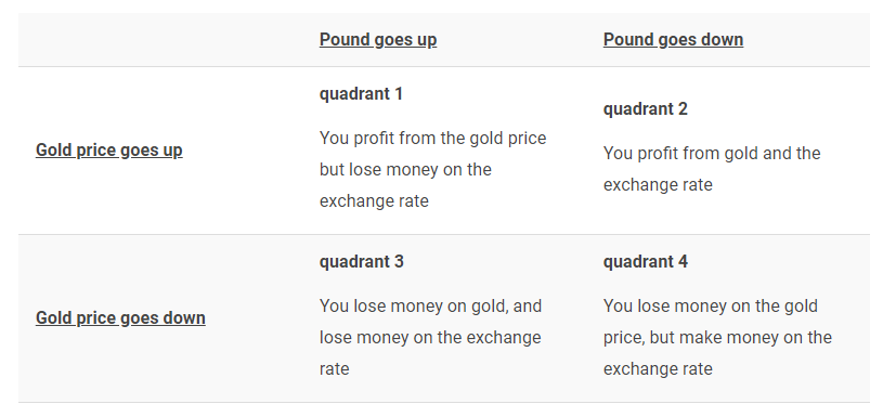
It shows all four possible outcomes for British investors. What I call “the four gold quadrants”.
The thing to understand is that these four quadrants are not equally likely to occur. Each one has a particular set of scenarios which will bring it about. Different combinations of money printing, GDP growth, inflation and everything else that can affect both the exchange rate and the gold price.
For example, during a financial crisis, the US dollar surges against just about all currencies. That means a weaker pound against the dollar. Gold is a safe haven, or safe investment. It spikes when risks in the economy rise, like in 2008.
This combination makes gold a brilliant investment for Brits because the currency move supercharges the gains from gold during a crisis — just when you want gold to perform an investment. As Quadrant 2 explains above, you profit from the gold price and the exchange rate.
Compare this to what happens to an American gold investor in a crisis. Their dollar currency is a safe haven. The US dollar surges alongside the gold price during a crisis. This decreases the benefit of owning gold, as it cancels out some of the gains.
Usually, gold surges faster than the US dollar, making gold a good crisis hedge for Americans too. But far less beneficial than for Brits.
Does it really work like this?
The proof is in the pudding…
Take a look at the charts below. The pound gold price hit all-time highs in 2019. The gold price in US dollars took far longer to hit all-time highs during the Covid-19 crisis.
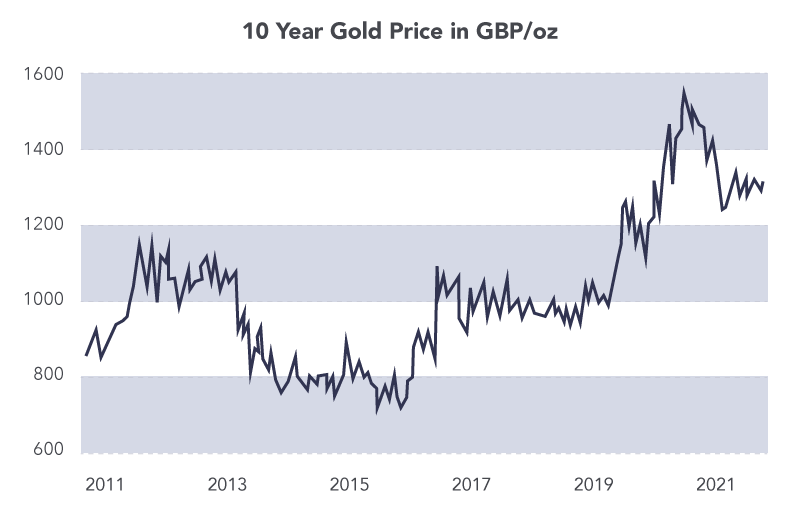
Source: LBMA
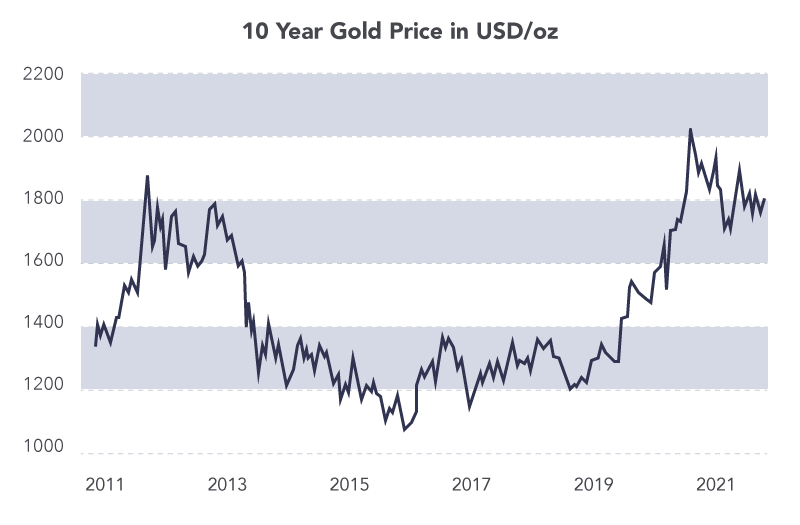
Source: LBMA
This is an example of currency moves supercharging your gold returns — Quadrant 2 in the table above.
The geopolitics of gold
The James Bond movie Goldfinger is a little mystifying to the younger generations.
Gold has little connection to the global economy or financial stability these days. Back when Goldfinger hit the screens, it was vital.
Still, every now and then gold makes a comeback into geopolitical headlines. Take for example the drama about German gold repatriation.
The German Court of Auditors responded to a growing conspiracy movement in 2012 by demanding the Bundesbank do an audit of its gold. The existence and weight had never been confirmed.
Worse still, in his 1955 autobiography the German central banker Hjalmar Schacht recalled his visit to the Federal Reserve. The Fed’s founding president Benjamin Strong “was proud to be able to show us the vaults, which were situated in the deepest cellar of the building, and remarked: ‘Now, Herr Schacht, you shall see where the Reichsbank gold is kept. “‘
Unfortunately, “At length we were told: ‘Mr. Strong, we can’t find the Reichsbank gold. “‘
Schacht told Strong: “Never mind; I believe you when you say the gold is there. Even if it weren’t, you are good for its replacement.”
But not any more, say the Germans. They want their gold back now that the Russians aren’t breathing down their necks… to the same extent as after World War 2.
But why? And why can’t the gold just be audited at the Fed and in the other locations around the world where Germany keeps its gold?
The Bundesbank explained the gold was to be repatriated to “build trust and confidence domestically, and the ability to exchange gold for foreign currencies at gold trading centres abroad within a short space of time.”
Unfortunately, a spokesperson for the central bank blurted out otherwise: it “is in case of a currency crisis.”
Having completed its repatriation of $28 billion in gold three years early, the Bundesbank in Frankfurt thought it was sitting pretty. Until someone found a World War 2 British “blockbuster” bomb down the road.
After all this drama, only about half of Germany’s gold is actually on domestic soil.
Germany’s repatriation was far from the only time gold made headlines in recent years. All sorts of conspiracies about gold continue to roll on.
Some have been vindicated.
Lately, the focus has been on China and Russia’s accumulation of gold, adding to their reserves. China only occasionally updates its estimates.
And many speculate the true holdings are vastly higher. Russia has the highest ratio of gold relative to its economy.
Why are these countries accumulating gold? More on that in a moment.
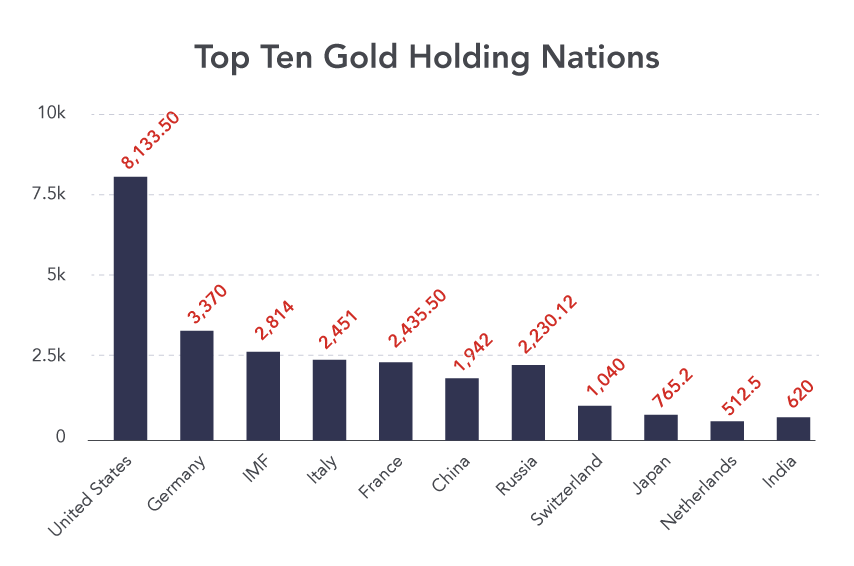
Source: Smaulgld
Meanwhile, the geopolitics of gold mining is changing too. The former powerhouse of South Africa has fallen badly. China is now the major producer of gold . Just look at this long-term chart to see how much of a change has come about.

The reason gold is so high on the agenda of geopolitics is historical. The experiment of fiat money (unbacked by gold) is still fairly new. The US dollar went off the gold standard in the 70s, ushering in an era of terrible inflation.
Today, the position of the US dollar as the world’s reserve currency is perceived as an unfair advantage by some nations. But if they want to turn away from the US dollar, where do they turn to?
Some nations are already using gold as the alternative. Iran, Russia and China, suffering under economic sanctions, use gold instead of US dollars in some international trade.
Perhaps gold is set for a return to the world monetary stage?
Gold market controversies
The most imminent threat to your gold investment comes from the questionable nature of the gold market. There is a long list of players who abuse the weaknesses in how gold is traded.
As described above, the gold price is financialised. It can easily be manipulated by people with no connection or interest in physical gold, but with financial market savvy. Or by those with the wrong sort of interests. It’s not just about traders looking to make a quick profit by manipulating the market.
The gold price is a measure of geopolitical tension. Governments want to hide their mismanagement of the economy by keeping gold prices low. A high price is an embarrassment because it signals scepticism of their plans. A lack of trust in the banking system and the currency.
Central bankers are sellers and buyers of gold. The gold price determines the return they get, or the cost of their purchases. Former chancellor of the Exchequer Gordon Brown famously sold a great deal of Britain’s gold at the low point off the gold price — a period now known as the Brown Bottom in honour of his mistake.
Thanks to all the controversy surrounding gold in financial markets, it’s best to own at least some of your gold outside the financial system.
How to buy physical gold
Many people are intimidated by the idea of buying physical gold as an investment. It feels so different from buying stocks on your online brokerage, or selling an investment property. But it isn’t any different than buying jewellery or diamonds. You simply go to a shop and purchase it.
Just like jewellery, there are more reputable sellers, cheaper ones and more convenient ones. All you have to do is make a quick comparison so your purchase is informed.
Because of gold’s properties as an investment, owning it in its physical form is a key part of the premise. It’s a real, tangible asset you can touch, hold and keep secret.
Investing in paper gold — ETFs or gold stocks — can be an excellent idea too. But missing out on the security of physical gold negates one of the metal’s key benefits. You still rely on a counterparty if you invest in paper gold, while the physical doesn’t require anyone to fulfil any obligations to you to realise its value.
Should you invest in gold? We think the answer is yes.
There are two basic methods of purchasing physical gold:
- Bullion: gold bullion is the cheapest way to purchase the physical metal. Bullion is essentially gold in its simplest form. It comes in “bars” of a wide variety of sizes. Some are cast, which means they are poured into an ingot mould. The rest are minted, meaning they are cut into shape from a piece of gold.
- Coins: these are a little more aesthetically pleasing than bullion. But please note that some coins — known as numismatics — are not valued for their gold content, but for other attributes (like their rarity or their physical condition).
It is debatable whether you are investing in gold when you buy a gold coin because of its rarity, or some other such feature. The price may not track the gold price as closely. And the mark-up can be so high that the gold content is not the relevant part of the investment. So please make sure you are aware of whether the coin you are buying is valued at the gold price, or the gold price plus some, often exorbitant, margin. If you’d like to invest in gold, steer clear of numismatics. Unless, of course, you can find them at bullion prices…
The value of gold bars and bullion-type coins, sometimes called semi-numismatics, is based purely on how much gold they represent by weight and purity.
The mark-up, known as a premium, on semi-numismatics should be small. Although a particularly reputable maker of bullion might command a slightly higher price, that’s because people feel surer about the purity and weight.
Pure gold?
Gold purity is usually measured in carats, sometimes spelt karats. The carat scale goes from 24ct, over 99.95% pure gold, all the way down to 9ct, which is under 40% purity. Copper and other metals are typically added when manufacturing jewellery, as gold by itself is too soft.
Fineness is a stricter way of measuring gold purity. This ranges from six nines fine — 999.999 parts of every thousand in fineness (or 99.9990 0 purity) — to the lower purities that are more practical for investors.

Six factors to keep in mind when purchasing gold
The methods available for buying gold are relatively straightforward. But that doesn’t mean you should go in blind.
Just like any investment, a thorough understanding of what you’re getting involved with is important. Not just of the gold itself, but of all of the corresponding elements that come with it:
- Counterparty risk: Perhaps the most important attribute of gold is that it carries no counterparty risk, if you own it in your possession. You are not dependent on any other person or entity when you own gold. There is no stockbroker or bank that can go broke, there is no government institution where you must register your title to prove your ownership, gold isn’t a share in company that can fail, there is no way the gold can be copied or resold and there is no exchange or clearing house that can close its doors on you. All this minimises the kind of risks that are important during a crisis, when banks are failing and governments freeze the financial system. But some ways of investing in gold relinquish the crucial advantage of not having counterparty risk. For example, some investors in gold discovered MF Global had tricked them out of their investments when the brokerage went bust in 2011. So, own your physical gold in your actual possession.
- Costs: This factor is very simple, but worth spending time on. And the big lesson is to do the maths! Make a table of costs for each way of purchasing gold you are considering, to work out just how much you are paying under each method. How much of a cost above the gold’s value are you taking on, which is known as the premium. How much would the gold price have to go up to recoup the costs?
- Size matters: A large purchase, both in terms of the size of the gold bar or coin and the size of the dollar purchase in total, can reduce the cost significantly. Once again, do the maths on all your options. It pays to be a little flexible too.
- Storage: Keep in mind the purpose of your gold. It’s no good depositing it in a bank if you’re worried about a financial crisis. Most people looking to “take delivery” of their gold are the kind who don’t trust the financial system. So stick with non-financial institutions if you wish to keep your gold secure. There are plenty of vault and storage options around Britain, but it’s best to choose one near you. If you choose to keep your gold at home in a safe or other safe place, don’t talk about it. Not to anyone. That can be difficult for a passionate gold investor, but it can end up being the source of plenty of sleepless nights if people know where your gold is kept. There are many websites dedicated to hiding gold in your home.
- Fraud and scams: The world of gold features plenty of unsavoury people, businesses and practices. It is crucially important to seek out the more reputable institutions, selling the most reputable version of whichever type of gold investment you decide on.
- Confidentiality: Some nations allow you to buy gold confidentially, up to certain amounts. Gold bullion dealers in Australia are required to record your identity if you purchase more than $5,000 worth of gold in a week. Regular cash purchases of less than $5,000 would leave no paper trail. That means nobody would know how much gold you own, or what price you paid for it.
Where British investors could go to buy gold
Gold coins:
- bleyerbullion.co.uk
- goldcore.co.uk
- royalmintbullion.com
- coininvest.com/en/
- bullionbypost.co.uk
- atkinsonsbullion.com
Gold bars:
What now?
Gold is a small, but crucial part of the portfolio of the modern-day investor. It always has been. But the financial industry has slowly tried to sway the British public against the precious metal. Just when it outperformed all other investments, too.
It’s obvious why financial advisers and brokers don’t like gold. It doesn’t earn them any fees and gold proves its worth precisely when the financial system is in turmoil.
That’s something which, of course, never happens. . . We think you should go ahead and buy one gold bar or semi-numismatic coin. See how it makes you feel. If it helps your wealth feel more robust, go ahead and invest a more substantial sum.
If you enjoy semi-numismatics like the UK’s sovereign, there are many very similar options from countries around the world. The Canadian Maple Leaf, South African Krugerrand, American Eagle and Australian Kangaroo are great options.
But buying pure bullion bars is the most basic way of investing in the gold price.
You pay the lowest premiums. Each different maker has their own.
All of this is just a brief introduction into the role, purpose and “meaning” of gold.
There’s a lot more to talk about and understand regarding what’s happening with gold and the changes in the world that could have a shocking impact on the price of gold in the 2020s and beyond.
If you’re intrigued by what’s been happening with gold lately, you’re sure to hear plenty more about it in Fortune & Freedom over coming weeks. But I hope this guide gave you an understanding of gold that helps you decide whether or not to invest.
Many thanks,

Nick Hubble
Editor, Fortune & Freedom
Strikes, shortages, crashing markets, surging prices…
As Britain hurtles back to the NIGHTMARE 1970s, Nigel Farage warns:
“Your Money Isn’t Working…”
Discover how you could fight inflation…
Plus: make 3 smart moves today and potentially boost your investments 10-fold.
All the details are HERE (completely FREE of charge)
Capital at risk. Forecasts are not a reliable indicator of future results.